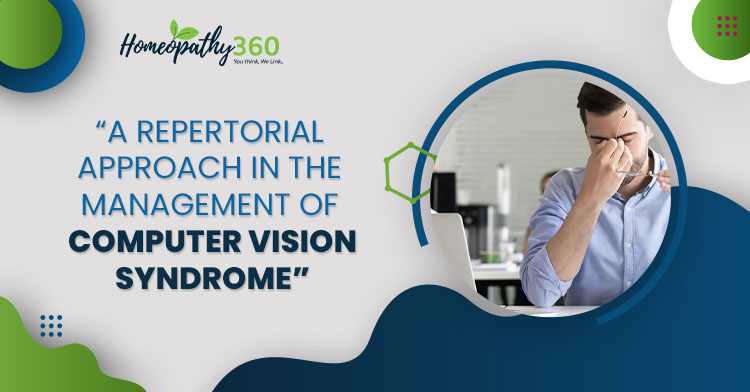
ABSTRACT:
Modern 21st century can be termed as an era of electronic gadgets specially of digital devices such as laptops, desktops, televisions, smartphones, tablets, etc. Use of these digital gadgets, Video Display Terminal’s (VDT) increased extensively from the past few years socially as well as professionally. Digital eye strain, also known as computer vision syndrome, comprises a range of ocular and visual symptoms, and estimates suggest its prevalence may be 50% or more among computer users. In this article an attempt is made to explain Computer Vision Syndrome and the reportorial approach for homoeopathic management.
KEY WORDS: Computer Vision Syndrome, Video Display Terminal (VDT), Digital eye strain, Asthenopia.
INTRODUCTION
Computers and Video Display Terminals are one amongst the most used tools in workplaces. In 21st century these became a basic requirement and are utilized in variety of organizations, including academic institutions, government offices and the financial system.1
Computer Vision Syndrome (CVS) is caused by prolonged usage of computer. The American Optometric Association (AOA) states computer vision syndrome as a collection of eye and vision disorders caused by activities that strain near vision and that occur in conjunction with or during the use of computers. It refers to set of visual symptoms that develop because of prolonged looking of a digital screen when the tasks demand exceeds the viewers capacities. The symptoms of CVS, also known as digital eye strain, include dry and irritated eyes, eye strain/fatigue, blurred vision, red eyes, burning eyes, excessive tears, double vision, headache, light/glare sensitivity, delay in shifting focus, and color perception irregularities.1
CVS is a serious public health issue that results in decreased workplace productivity, higher error rates, lower job satisfaction, and compromised visual ability. Approximately 60 million individuals globally suffer from CVS, with 1 million new instances occurring each year, according to statistics. CVS is becoming an increasing public health concern that has the potential to negatively impact employees’ quality of life and productivity.
EPIDEMOLOGY/ PREVALENCE2
According to the American vision council, at least 60% of American men and 65% of American women reported symptoms of CVS. Simultaneous use of two or more devices increased the risk of CVS compared to the use of a device at a time and reported prevalence was 75% and 53% respectively. Magnitude of CVS in Brazil is 54.6%, in UAE is 73.9%, in Malaysia is 63%, in Mauritius is 59.3% and in Chennai (India) is 80.35% among the computer users.
RISK & ETIOLOGICAL FACTORS 3,4
1. Refractive errors
- Hypermetropia
- Astigmatism
2. Abnormal binocular interaction
Abnormalities of vergence may cause asthenopia with prolonged use of eyes
- Convergence insufficiency
- Poor vergence facility
- Decompensated heterophoria
3. Accommodation abnormality
The triad of near reflex or near response or near synkinesis happens when an individual focuses on near objects. This triad consist of accommodation, miosis and convergence. Problem with any of the components of this reflex may cause difficulty or strain in near work
- Uncorrected presbyopia
- Poor accommodative facility
- High accommodative lag
4. Dry eye
Dry eye is the important source of discomfort in VDT users. Multiple factors increase the risk of dry eye condition in users of digital devices, especially computers. These include
- Female sex: especially postmenopausal women
- Higher age
- Use of contact lens
- Incomplete eye closure during sleep
- Environmental factors: Air conditioners, Dry air, Dust, Building contaminants, Exhaust fans, Low humidity
- Reduced blinking: the normal blinking rate is 15-20/min, the blinking rate is reduced while working on VDT. This results in opening of eyes for longer duration and hence results in increase chances of dryness of eye.
- Lid condition: Anterior blepharitis, Meibomian gland dysfunction.
5. Suboptimal properties of the digital devices
- Blue light: now a days most of the digital screens are LED (light Emitting Diode) known to emit blue light which may cause damage to the retina.
- Quality of display: various configurations of display may predispose to CVS.
- Low resolution of the screen
- Poor image stability
- Poor readability and legibility
- High brightness and high contrast
- Words with capital letters are difficult to interpret compared to sentence case
- Less than one character space between lines
- Light characters against dark background or dark characters against light background
- Low refresh rates of the screen below 30-50Hz
- Reflections
6. Other factors
- Improper sitting position during work, bending forwards to get clear screen images
- Inadequate lighting in the room
- Improper angulation of the screen
- Frequent switching between digital display and hard copies with different background
- Decreased hydration: decreased intake of water increases the risk of dry eye
SYMPTOMS3,4
Symptoms may range from mild discomfort to severe extra ocular manifestations
A) Visual symptoms:
- Blurred vision
- Diplopia
- Presbyopia
- Focus change difficulties
B) Ocular – Internal symptoms (Asthenopic):
- Eye strain
- Pain in the eye
- Pain around the eyes
- Tiredness of eyes
- Soreness of eyes
C) Ocular – External symptoms:
- Burning
- Dryness
- Redness
- Irritation
- Lachrymation
D) Extraocular symptoms:
- Shoulder pain
- Neck pain
- Neck stiffness
- Backache & Headache
EXAMINATION & EVALUATION 3,4
History of:
- Occupation
- Duration of work
- Use of glasses
- Lighting in work place
- Ergonomics
Ophthalmic examination for:
- Visual acuity
- Refraction
- Intraocular pressure
- Slit lamp examination of anterior segment & posterior segment
- Cornea: Corneal opacity can increase the glare from digital screens
- Pupils: A large pupil may cause visual fatigue due to reduced depth of focus
- Blinking: Works that needs concentration are known to reduce the blinking rate
Questionnaires available to determine the severity of CVS:
- Dry Eye Questionnaire (DEQ-5) validated by Robin L. Chalmers & Barbara Caffery.
- Questionnaire by Hayes & Colleagues.
- Visual fatigue scale by Dr K A Lee, Hicks G, Nino-Murcia G.
- Computer vision symptom scale by Mariano Gonzalez-Perez, Rosario Susi, Beatriz Antona, Ana Barrio, Enrique Gonzalez.
- CVS questionnaire (CVS-Q) by Segui Mdel m, Cabrero-Garcia J, Crespo A, Verdu J, Ronda E.
PREVENTION 3,4
- Early intervention for refractory errors
- Frequent blinking of eyes to prevent the dryness
- Maintaining good ergonomic posture
- Keeping the screen at an angle of 20 degrees
- Avoiding direct fall of light on the screen
- Cleaning the dust present on the screen
- Taking short breaks at regular intervals
- Use of anti-reflective films over screen
- 20-20-20 Rule: for every 20 minutes taking break for 20 seconds and shifting focus from the screen at a distance of 20 feet or more
- Eye exercises to relieve the strain
- Palming: Cupping of warm palms over eyes and forehead for 2 minutes
- Closing the eyes tightly for few seconds in between the work
- Circular massage over eyes with gentle pressure for few minutes with tip of ring finger
REPERTORIAL APPROACH
A) Some of the rubrics related to Computer Vision Syndrome from “Boenninghausen’s Therapeutic Pocket Book” (BTPB).5
| SECTION | CHAPTER | RUBRIC | SUB RUBRIC | PAGE NO |
| Parts of the body & organs | Eyes | Eye balls | 30 | |
| Parts of the body & organs | Eyes | Staring | 34 | |
| Parts of the body & organs | Vision | Dazzling | 35 | |
| Parts of the body & organs | Vision | Double | 37 | |
| Parts of the body & organs | Vision | Far-sighted | 38 | |
| Parts of the body & organs | Vision | Letters run together when reading | 38 | |
| Alterations of the state of health | Aggravations | Exertion of vision | 281 | |
| Alterations of the state of health | Aggravations | Looking around | At a bright light | 288 |
| Alterations of the state of health | Aggravations | Looking around | Long at anything | 288 |
| Alterations of the state of health | Aggravations | Looking around | At shining objects | 288 |
B) Some of the rubrics from Kent’s “Repertory of the Homoeopathic Materia Medica” with respect to Computer Vision Syndrome.6
| CHAPTER | RUBRIC | SUB RUBRIC | PAGE NO |
| Eye | Astigmatism | 235 | |
| Eye | Close | Spasmodic closure, headache with | 236 |
| Eye | Contractive sensation | 237 | |
| Eye | Dryness | 238 | |
| Eye | Dryness | Artificial light, in | 238 |
| Eye | Dryness | Looking at bright light | 238 |
| Eye | Heaviness | 241 | |
| Eye | Irritation | 244 | |
| Eye | Looking | Steadily | 246 |
| Eye | Pain | 248 | |
| Eye | Pain | Changing from dark to light and light to dark | 249 |
| Eye | Pain | Dryness of eyeballs, with | 249 |
| Eye | Pain | Exertion of vision, from | 249 |
| Eye | Pain | Light, artificial | 249 |
| Eye | Pain (aching) | Light, bright agg | 252 |
| Eye | Pain (aching) | Looking sharply | 252 |
| Eye | Pain (burning) | Exertion of vision | 253 |
| Eye | Pain (burning) | Looking sharply, when | 253 |
| Eye | Redness | 264 | |
| Eye | Staring | 265 | |
| Eye | Stiffness | Of eyeballs | 266 |
| Eye | Tired | Sensation | 268 |
| Vision | Accommodation | Defective | 271 |
| Vision | Blurred | 271 | |
| Vision | Blurred | Letters | 271 |
| Vision | Diplopia | 277 | |
| Vision | Exertion | Of vision agg | 278 |
| Vision | Hypermetropia | 280 | |
| Head | Pain | Straining eyes, from | 149 |
C) Rubrics related to CVS from “Boger Boenninghausen’s Characteristics & Repertory” (BBCR).7
| CHAPTER | SECTION | RUBRIC | SUB RUBRIC | PAGE NO |
| Eyes | Aching | 310 | ||
| Eyes | Burning | 310 | ||
| Eyes | Dry | 312 | ||
| Eyes | Exhausted, tired feeling in | 312 | ||
| Eyes | Heaviness in | 313 | ||
| Eyes | Lachrymation | 314 | ||
| Eyes | Pain | Simple | 315 | |
| Eyes | Pain | Eyeball, in | 315 | |
| Eyes | Red | 316 | ||
| Eyes | Smaller | Must make | 316 | |
| Eyes | Staring | 317 | ||
| Eyes | Stiff | 317 | ||
| Eyes | Strained feeling | 318 | ||
| Eyes | Aggravation | Eyestrain | 335 | |
| Eyes | Aggravation | Light | Artificial | 336 |
| Eyes | Aggravation | Looking | Continued at an object | 336 |
| Eyes | Aggravation | Reading | 336 | |
| Eyes | Vision | Blurred | 338 | |
| Eyes | Vision | Dazzled (by light) | 339 | |
| Eyes | Vision | Presbyopia | 345 | |
| Eyes | Vision(Aggravation) | Light | Artificial | 346 |
| Eyes | Vision(aggravation) | Looking a long time | At an object | 346 |
| Eyes | Vision(Aggravation) | Straining vision | 347 | |
| Head (Internal) | Aggravation | Eyes | Strain, after | 284 |
D) Some of the rubrics from William Boericke’s “Pocket Manual of Homoeopathic Materia Medica & Repertory” (page numbers are indicated in brackets) 8
Chapter EYES
EYE-BALLS
- Bad effects from electric or artificial light- (718)
- Burning, smarting- (718)
- Dryness, heat- (718)
- Heaviness- (718)
SENSATIONS
- Burning and smarting- (720)
- Heaviness- (720)
- Stiffness- (720)
PAIN
- Eye balls- (723)
- Supra orbital- (723)
TYPE
- Aching, sore- (723)
- Burning, smarting- (723)
- Strained, stiff feeling- (724)
ASTHENOPIA – eye strain, with spasm of accommodation- (727)
ASTIGMATISM- (727)
DIPLOPIA- double vision- (727)
HYPERMETROPIA- (727)
E) Some of the rubrics related to CVS from “A Concise Repertory of Homoeopathic Medicines by DR. S R. Phatak”.9
- ASTHENOPIA
- ASTIGMATISM
- DIPLOPIA
- EYES, Dry
- EYES, Heavy, as if
- EYES, Light, artificial agg
- EYES, Red
- EYES, Seeing, sight, cinema, etc agg
- EYES, Sore, bruised, aching
- EYES, Sprained, as if
- VISION, Accommodation disturbed
- VISION, Asthenopia
- VISION, Astigmatism
- VISION, Dazzled, bright
- VISION, Diplopia
- VISION, Errors of
- VISION, Light, artificial agg
- VISION, Weak, headache, with
F) Some of the rubrics related to CVS from “Synthesis 1.3 Android app” created by Archibel SA based on Synthesis Repertory version 2009, Editor: Dr Frederick Schroyens. 10
- EYE – ASTHENOPIA
- EYE – ASTHENOPIA – accompanied by – Head – pain
- EYE – ASTHENOPIA – muscular
- EYE – ASTHENOPIA – muscular – External recti
- EYE – ASTHENOPIA – muscular – Internal recti
- EYE – ASTIGMATISM
- EYE – DRYNESS
- EYE – DRYNESS – exertion of eyes; as from
- EYE – DRYNESS – light; from artificial
- EYE – DRYNESS – looking at bright light
- EYE – EXERTION – agg
- EYE – EXERTION OF THE EYES agg
- EYE – FOCUS – difficult to
- EYE – IRRITATION – light; from artificial
- EYE – LIGHT; from – artificial light – agg
- EYE – LIGHT; from – bright light – agg
- EYE – PAIN – aching
- EYE – PAIN – exertion of the eyes – after
- EYE – PAIN – light; from – artificial light – agg
- EYE – PAIN – light; from – bright light
- EYE – PAIN – straining eyes
- EYE – PAIN – Eyeballs
- EYE – STRAINED
- EYE – TIRED SENSATION – sight-seeing, moving pictures, etc; after
- VISION – ACCOMMODATION – defective – overexertion
- VISION – BLURRED – light; from – artificial light, agg
- VISION – DAZZLING – looking long
- VISION – DIPLOPIA – overwork at the desk
- VISION – HYPERMETYROPIA – overuse of eyes in fine work
- VISION – LIGHT: from – artificial light, agg
DISCUSSION
A dissertation titled “The efficacy of Ruta graveolens 6CH together with ergonomic interventions in the work place in the treatment of computer vision syndrome” by Zeenat Hassim in the University of Johannesburg, in this study with sample size of 29, interventional group 15, control group 14, in which the null hypothesis stating Ruta graveolens in a 6CH potency together with ergonomic intervention would not be effective in the treatment of computer vision syndrome is accepted as the participants who received the remedy showed no more of an improvement than those that received the placebo. One such study with small sample is not enough to determine the efficacy of homoeopathic remedy in the treatment of computer vision syndrome. A larger sample size would be more reliable and accurate way to determine the efficacy of any drug.11
In various Homoeopathic literatures, Materia Medica and Repertories commonly indicated high grade remedies for Asthenopia, Computer vision syndrome are Argentum nitricum, Causticum, Cimicifuga racemosa, Gelsemium sempervirens, Mercurius solubilis, Natrium muriaticum, Phosphorus, Physostigma venenosum, Rhus toxicodendron, Ruta graveolens, Sepia officinalis, Spigelia anthelmia, Sulphur, etc. The efficacy and role of these remedies in the treatment of computer vision syndrome should be explored in the further clinical studies.
CONCLUSION
Computer vision syndrome is affecting individuals of all age groups. Use of video display terminal’s is the major predisposing factor in the development of this condition. Education and creating awareness among the people about predisposing factors and ergonomic recommendations for the use of smartphones, computers, television and other video display terminal’s is the need of hour. In addition, use of homoeopathic similimum according to the totality of symptoms helps in alleviating symptoms as well as in the treatment of the condition.
REFERENCES
1. Adane F, Alamneh YM, Desta M. Computer vision syndrome and predicators among computer users in Ethiopia: a systematic review and meta-analysis. Tropical medicine and Health; 2022. 50(26).
2. Sheppard AL, Wolffsohn JS. Digital eye strain: prevalence, measurement and amelioration. BMJ Open Ophthalmology ; 2018.e000146.
3. Koushik T, Vatinee YB, Augustine H, Priya RC. Computer Vision Syndrome(Digital Eye Strain). American Academy of Ophthalmology, EyeWiki, 2022. http://eyewiki.aao.org/w/index.php?title=Computer_Vision_Syndrome_(Digital_Eye_Strain)&oldid=79500
4. Smitha VK. Asthenopia. Kerala Journal of Ophthalmology. 2012 Mar; 24(1)
5. Allen TF. Boenninghausen’s Therapeutic Pocket Book. B Jain Publishers; 2003.
6. Kent JT. Repertory of the Homoeopathic Materia Medica. Enriched Indian ed. New Delhi. B Jain Publishers; 2017.
7. Boger CM. Boger Boenninghausen’s Characteristics Repertory with corrected Abbreviations and word index. USA. B. Jain publication; 2015.
8. Boericke W. Pocket manual of Homoeopathic Materia Medica and Repertory. 9/e. New Delhi. Jain Publishers; 2012.
9. Phatak SR. Concise Repertory of Homoeopathic Medicines. B Jain Publishers;2004.
10. Archibel SA. Synthesis 1.3 Android app based on Synthesis Repertory Dr Frederick Schroyens; 2009.
11. Zeenat H. The efficacy of Ruta graveolens 6CH together with ergonomic interventions in the work place in the treatment of computer vision syndrome. University of Johannesburg; 2010.
Author:
Dr Rohan Arabhavi
PG scholar, Part 1
Dept of Case Taking and Repertory
UNDER THE GUIDANCE OF
Dr Anupama I K
Assistant professor, PG guide Government Homoeopathic Medical College & Hospital, Bengaluru.




